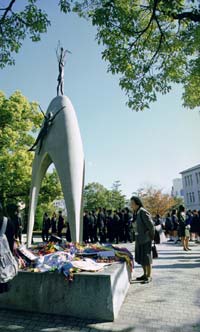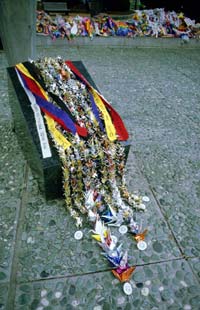In early April of 1998 while driving cross-country on my first visit to the Peace Pilgrim Center in Hemet, I found myself outside of Lincoln, Nebraska on a cold, gray, rainy afternoon. I was looking for Don Tilly and the Prairie Peace Park, a 28 acre teaching center dedicated to peace.
I had met Don in New Jersey a week earlier and was taking him up on an invitation to visit on my way west. I pulled up to the gate of the Peace Park as it was getting dark. Don took me to dinner at a nearby restaurant and we returned for a tour. The rain and darkness prohibited a visit to the outdoor attractions so we walked slowly through the rooms of the main building as Don explained the significance of the various displays.
One story in particular captured my attention. It was about a Japanese girl named Sadako Sasaki. Sadako was two years old and a resident of Hiroshima when the first atomic bomb used on a civilian population was dropped on that city on August 6, 1945. When she was eleven, Sadako developed leukemia a common disease among children exposed to atomic radiation.
While being treated in the hospital, Sadako was visited by a friend who taught her to fold paper origami cranes. An old Japanese legend stated that anyone who folded 1000 cranes would be granted a wish. In Japan the crane is symbolic of long life, health, and peace. Sadako’s wish was to be returned to good health and beyond that that all children who innocently suffer from the consequences of war would be healed and that in the future no children should so suffer. Inspired to realize this dream, Sadako began her quest to fold 1000 cranes.
In the following months Sadako managed to fold over 600 cranes. But her disease gradually worsened and finally claimed her life. Her classmates, inspired by her courage, folded the remainder and she was buried with 1000 origami cranes. The story of Sadako’s quest and courage spread all over Japan and children throughout the country folded “Peace Cranes” and raised money to build a children’s memorial in the Hiroshima Peace Park. In 1958, three years after her death, the monument became a reality. It shows Sadako standing on the mountain of paradise holding a giant golden origami crane overhead in her outstretched arms. At its base is the inscription, “This is our cry, this is our prayer, Peace in the World.”
I had never heard this story before but was deeply moved by it and fascinated by the delicate paper cranes. Don kindly let me unroll my sleeping bag on the floor in a room not far from the Sadako display and I spent the night safe and dry as the cold rain fell in the darkness outside.
The next morning I continued west across Nebraska. The clouds had begun to break up and light slowly began to seep back into the wet landscape as I traveled through the rolling grasslands bordering the North Platte River. I was surprised to notice some large birds standing in the fields along the highway. As I drove on into the morning, the flocks grew larger and larger until these tall gray birds with huge wingspans and red spots at the top of their heads filled the fields and the sky.
In the midst of my amazement at this awesome sight, the memory of a news story heard a few weeks earlier came to mind. It had described a major migration that was taking place in the American west – that of the Sandhill Crane. With a rush of association that brought goose bumps to my arms and a tingle to the back of my neck, I connected the story I had heard the night before with the spectacle unfolding around me. Over the next 150 mile I drove by as many as 50,000 migrating Sandhill Cranes who flew Sadako’s story across the Nebraska sky. I felt I was receiving a great blessing and have since thought of it as my “Gift of Cranes.”
But the story doesn’t end here. The next chapter unfolded about two weeks later when I arrived at the Peace Pilgrim Center in Hemet, California. One of the very first things I noticed when I entered the house was a large bowl of paper origami cranes sitting on the kitchen table and almost immediately after that discovered a copy of the book “Sadako and the 1000 Cranes” on top of a pile in the front room. That tingle was back in my neck.
I read the book immediately and a few days later met the woman who had folded the cranes and had her teach me how to create them myself. I have since tried to fold at least one crane every day, and think of each as a “prayer for peace”. I have had the great pleasure of passing along these messengers of peace as I travel and enjoy sharing the story of my “gift” and teaching others the magic of turning squares of paper into delicate origami cranes.
In early 1999 I discovered a website about a grammar school in Hiroshima that sponsored a yearly “cranes for peace” project. Working with a group of children and adults at my local church, I told the story of Sadako and gave instructions in folding origami cranes. Over the course of the next few months, our group folded cranes and strung them in groups of 100 until we had collected 1000. These were sent to the school in Japan and joined 87,000 others from all over the world that were brought to the Children’s Peace Memorial in the first week of August as part of the school’s annual peace ceremony.
I have since completed a personal 1000 origami cranes. They hang, for now, in the sanctuary of the church I attend in Connecticut. But I have other plans for them. On December 12th of this year, 2001 people will gather in Hiroshima to pray for peace. I plan to be there with my cranes. They and I will complete a journey that began over two years ago: one that will take them home to the source of their inspiration. To rest, at last, in the shadow of the statue of Sadako - a young Japanese girl I never knew – who changed my life on a rainy night in the middle of Nebraska.  
| Children's Peace Memorial- Hiroshima | 1000 Origami Cranes | |


